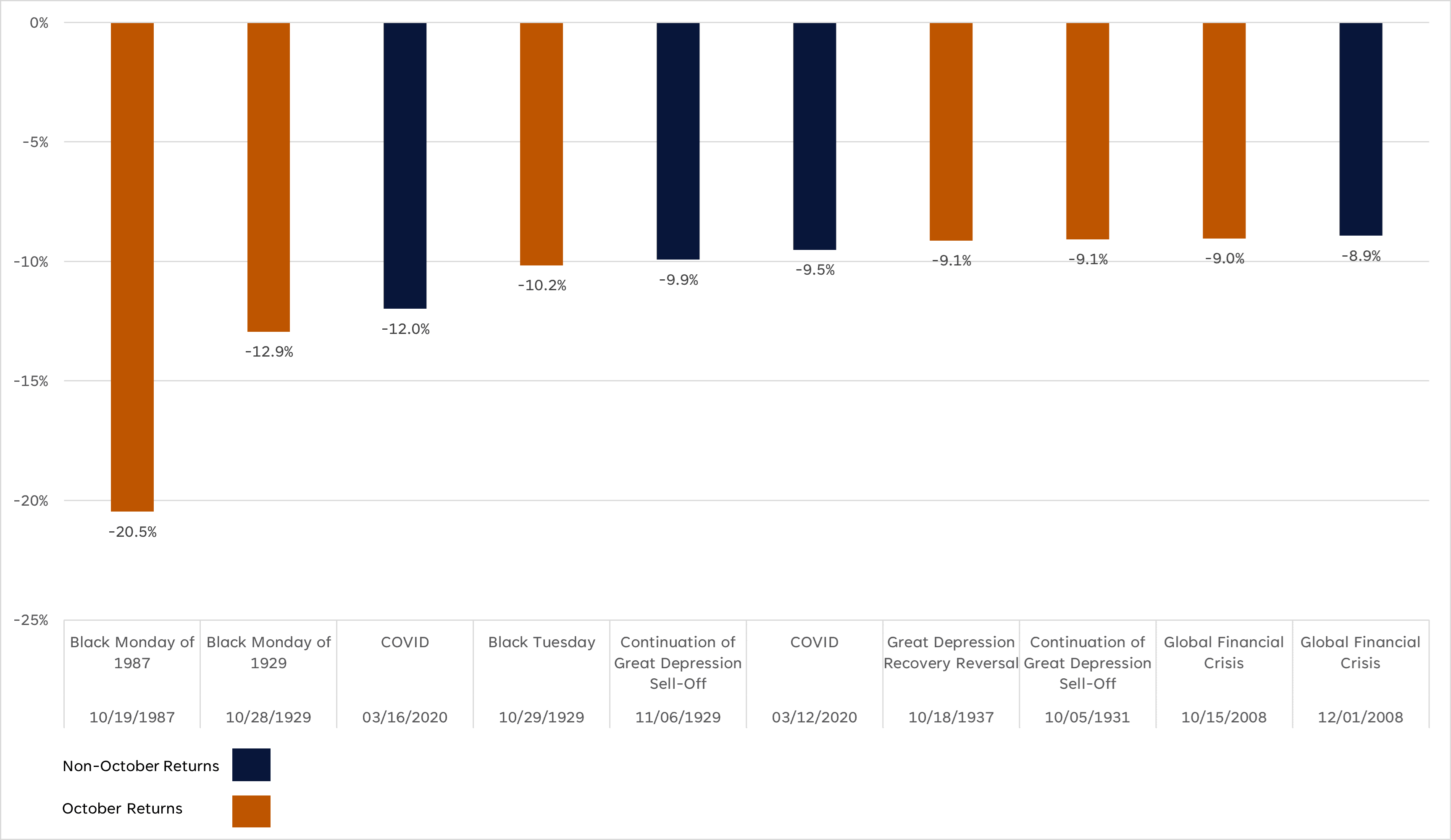Goldman Sachs expects Nvidia ’beat and raise,’ lifts price target to $240
Today marks the 96th anniversary of “Black Tuesday”, October 29, 1929, the second day of a two-day sell-off that saw the S&P 90 Index (predecessor to the S&P 500) fall 21.8%, making it the second-worst two-day decline in the indexes’ nearly 100-year history, trailing only the 1987 crash referred to as “Black Monday”, where markets declined 24.6% from October 16–19.
“Black Tuesday” ranks as the fourth-largest daily decline in the S&P 500’s history, as the index fell 10.2%. The previous day in 1929, coincidentally also called “Black Monday”, experienced the second-largest drawdown in history, with the index declining 12.3%. The S&P 500 has only realized a daily loss of greater than 10% four times in its history, with two of those double-digit losses occurring in this two-day stretch in 1929 and the only occurrence of consecutive double-digit daily declines.
Interestingly, October has realized some of the largest single-day declines in market history, with six of the top 10 and nine of the top 20 declines occurring in the first month of the fourth quarter. Other notable declines included October 18, 1937 (S&P 90), down 9.3% following the initial recovery from the Great Depression, and October 15, 2008, dropping 9.0% at the height of the Global Financial Crisis.

Source: LPL Research, FactSet 10/27/25
The “October Effect”
So why has October experienced some of the largest daily drawdowns?
Major stock market crashes in past Octobers, namely the crashes of 1929 and 1987, have created a psychological “October Effect” where investors believe the market will trade lower based on history. Other contributing factors to the “October Effect” include end-of-year portfolio rebalancing, which may cause increased trading volume and price swings, as well as third quarter corporate earnings, where earnings results and year-ahead outlooks can introduce market volatility, causing sharp market reactions.
While some of the largest drawdowns have occurred in October, the “scary" month has delivered positive returns more often than not, with an average monthly return of +0.4% since the inception of the S&P 500’s predecessor index, the S&P90 (January 3, 1928), and a positive return occurring 60% of the time.
More recently, October has been one of the better months in the stock market, with an average gain of approximately 2.1% since 2000, with 18 of the 25 months over the period being positive. Volatility has been prevalent, though, with the worst monthly performance occurring in 2008, down nearly 17%, and the strongest month in 2011, up 10.8%.
With October coming to a close at the end of this week, the S&P 500 has realized a 3.0% gain as of October 28, 2025 — bucking the psychological “October Effect”. Assuming no meaningful events impact markets in the next few days (although the “Magnificent Seven” constituents are set to report earnings later this week, which may cause large market gyrations given their relative size in the S&P), this October would mark the ninth-best October in the last 25 years. It’s also worth noting that the largest daily drawdown since the global tariff announcement back in April occurred this month, a 2.7% drawdown on October 10, highlighting the month’s relative volatility.
Conclusion
While some of the big market declines in October throughout history are scary, markets continue to grind higher, with the S&P 500 hovering near record highs. LPL Research’s Strategic and Tactical Asset Allocation Committee (STAAC) remains neutral equities, favoring large cap stocks over small caps, coupled with a tilt towards growth stocks over value. Regionally, we remain neutral across domestic, developed, and emerging markets, as the upside potential from AI in domestic equities balances the foreign upside potential from further U.S. dollar weakness. The STAAC remains neutral core bonds with a slight preference for mortgage-backed securities over investment-grade corporate bonds. Outside of traditional asset classes, the STAAC remains positive on alternative investments, as we believe they can help strengthen portfolio stability during periods of volatility.
***
Important Disclosures
This material is for general information only and is not intended to provide specific advice or recommendations for any individual. There is no assurance that the views or strategies discussed are suitable for all investors. To determine which investment(s) may be appropriate for you, please consult your financial professional prior to investing.
